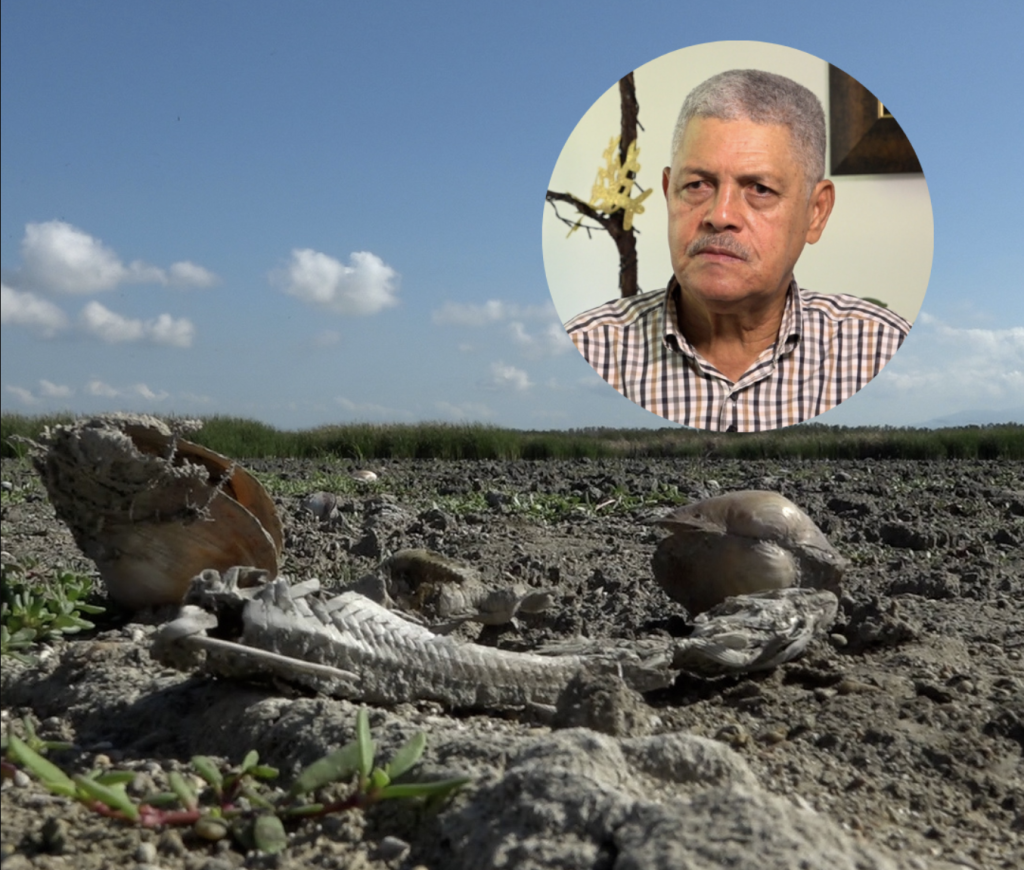
For years, those in the know have been warning of a disaster in the making. It is here. Now.
The Laguna de Cabral, a vital wetland in the province of Barahona, is facing rapid collapse, prompting a stark warning and an urgent plea for a state of emergency declaration from a leading environmental authority.
Luis Carvajal, coordinator of the Environmental and Natural Resources Commission at the Autonomous University of Santo Domingo (UASD), warned that the lagoon “is drying up rapidly” due to water diversion, describing the situation as an escalating environmental catastrophe.
The severity of the crisis was visually confirmed by the production team of the program Toda la Verdad, hosted by journalist Odalis Castillo, which visited the site. Their cameras captured a largely dry lagoon and the desperate testimonies of fishers and farmers demanding intervention.
The investigation revealed ancient riverbeds now transformed into cracked, dry earth—a grim testament to the deterioration. Journalists also observed the sluice gate that local residents claim is keeping water retained, preventing its natural circulation. Community members argue that releasing the flow would allow water to benefit local farmers, ranchers, and fishers through the various irrigation channels.
Today, with vast stretches of the lagoon dried, the reality is bleak: fish have perished, migratory birds are absent, and dozens of local families are counting daily losses of resources and sustenance.
Carvajal was unequivocal in his denunciation for Toda la Verdad, stating that the water management practices leading to the drying up of the Laguna de Cabral constitute grave violations of Dominican environmental law.
“Yes, Law 64-00 on Environment and Natural Resources and Law 202-04 on Protected Areas are being violated,” Carvajal asserted. He specifically pointed to a controversial 2006 agreement: “Furthermore, preeminence has been granted to an illegal and unconstitutional agreement signed in 2006, which assigns more than two-thirds of the water flow to Barahona’s Central Sugar Consortium (Consorcio Central Azucarero), also making it the arbiter of the process while being the principal interested party. That agreement must be annulled immediately.”
The UASD environmental coordinator implored the Dominican government to declare the area an environmental state of emergency. He stressed that the destruction of the wetland is severely impacting the region’s biodiversity, jeopardizing the livelihoods of local fishers, and destabilizing the ecological balance of the entire southwest of the country.
Carvajal attributed the current drought directly to the manipulation of the natural water flow, exacerbated by a lack of oversight and the absence of sustainable policies within the Yaque del Sur basin.
As part of the immediate, necessary steps, Carvajal proposes:
Control of the Santa Ana dike.
Rehabilitation of the Trujillo dike.
Implementation of permanent monitoring for water flow and quality.
He emphasized these actions are “essential to stop the collapse of the ecosystem and preserve life around the lagoon.”
Castillo for Toda la Verdad said that the Consorcio Azucarero Central denies the blame for the drying up of the canal.
Carvajal disputes this and told the Toda La Verdad reporter that the past director of Indrhi, Frank Rodriguez signed an agreement that assigned two/thirds of the water to the Consorcio Azucarero and put the management of the distribution under the foreign-owned sugar company. Carvajal says this was the first de facto privatization of water in the Dominican Republic.
The ecologist is participating in the drafting of a report on the damages. He explained that the lagoon receives water from the Rio Yaque del Sur. He says there is the need for attention to the sources of water of the Yaque del Sur in the Valle Nuevo and Armando Bermudez mountain natural parks. But he insists the main problem that is causing the drying of the lagoon is generated by the irregular allotment and management of the water source in Barahona to a private company in violation to local laws. He says this is impacting fish population and migratory birds, and the livelihood of 30,000 families.
He called for declaring the area in a state of emergency and obliging that the Indrhi take back the control of the situation, and rehabilitate the Trujillo and Santa Ana dikes and continuously monitor the quantity and quality of the water.
Follow the story:
YouTube Toda la Verdad
Panorama
27 October 2025

